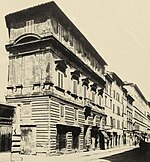Palazzo Rusticucci-Accoramboni

The Palazzo Rusticucci-Accoramboni (also known as Palazzo Rusticucci or Palazzo Accoramboni) is a reconstructed late Renaissance palace in Rome. Erected by the will of Cardinal Girolamo Rusticucci, it was designed by Domenico Fontana and Carlo Maderno joining together several buildings already existing. Due to that, the building was not considered a good example of architecture. Originally lying along the north side of the Borgo Nuovo street, after 1667 the building faced the north side of the large new square located west of the new Saint Peter's Square, designed in those years by Gian Lorenzo Bernini. The square, named Piazza Rusticucci after the palace, was demolished in 1937–40 because of the erection of the new Via della Conciliazione. In 1940 the palace was dismantled and rebuilt with a different footprint along the north side of the new avenue, constructed between 1936 and 1950, which links St Peter's Basilica and the Vatican City to the center of Rome.
Excerpt from the Wikipedia article Palazzo Rusticucci-Accoramboni (License: CC BY-SA 3.0, Authors, Images).Palazzo Rusticucci-Accoramboni
Via della Conciliazione, Rome Municipio Roma I
Geographical coordinates (GPS) Address Phone number Website Nearby Places Show on map
Geographical coordinates (GPS)
| Latitude | Longitude |
|---|---|
| N 41.902694444444 ° | E 12.46 ° |
Address
Ambasciata di Croazia presso la Santa Sede
Via della Conciliazione 44
00193 Rome, Municipio Roma I
Lazio, Italy
Open on Google Maps











